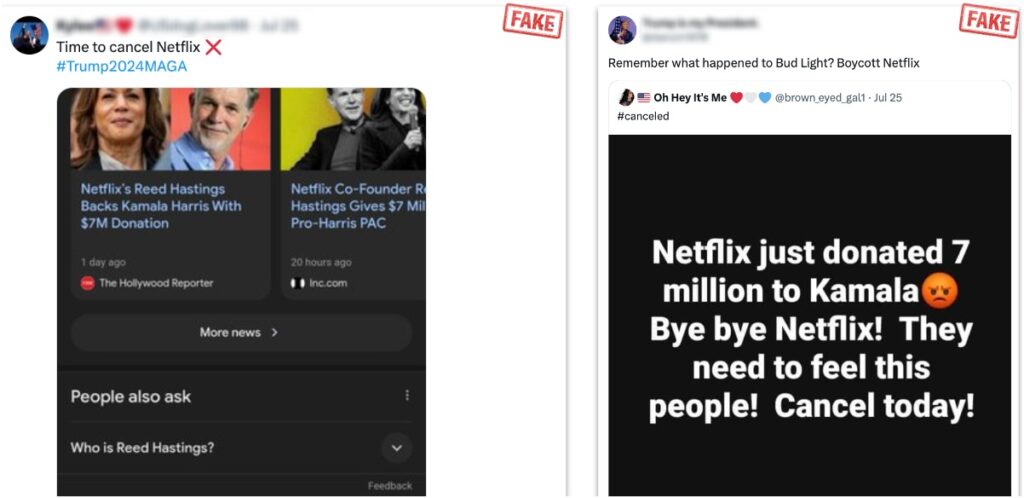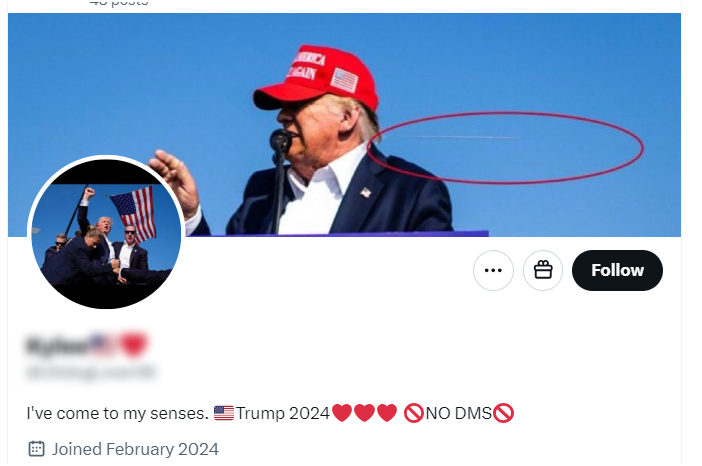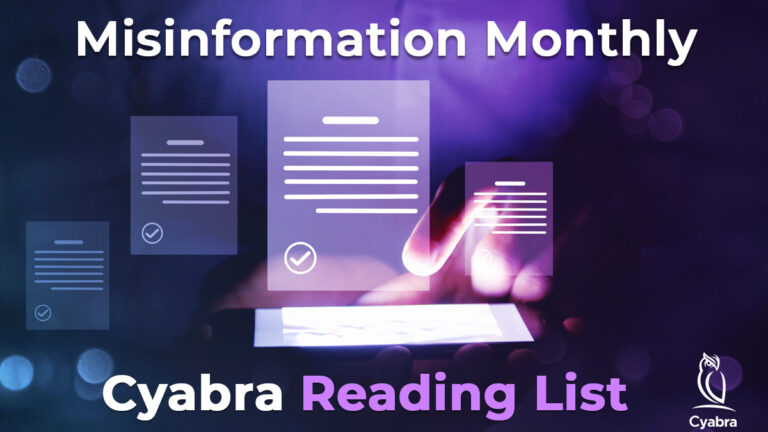As the most popular streaming platform with approximately 238 million paid subscribers worldwide, Netflix is no stranger to consumer backlash or fake news.
Recently, however, the company faced an attack that combined both factors and, fueled by fake profiles, turned into a major online crisis.
This incident is yet another example of brands being swept into the tidal wave of election disinformation. Here’s what happened:
TL;DR?
- The hashtag #CancelNetflix reached 309 million views within just one week.
- 24% of the profiles that targeted Netflix on X were fake, and pushed anti-Harris content.
- Content spread by the fake profiles reached a potential 19.5 million views.
Netflix’s Newest Hit: the Bot Attack
The backlash against Netflix began after the company’s co-founder and former CEO, Reed Hastings, donated $7 million to Vice President Kamala Harris’s presidential campaign. Although Hastings made the donation as a private individual, posts calling for a boycott and the cancellation of Netflix subscriptions falsely attributed the donation to the company itself. The most influential post spreading this misinformation came from the verified account of influencer Shannon Lancer, using the handle “Patriot for President Trump”. Lancer’s post reached a potential audience of 84 million views.
This misinformation, initially spread by authentic profiles, was quickly amplified by hundreds of fake ones. Cyabra’s analysis revealed that 24% of the profiles promoting these false narratives were inauthentic. Using the hashtags #BoycottNetflix and #CancelNetflix, the fake profiles joined the backlash within hours of the conversation gaining traction and intensified their activity with each passing day. At the peak of the fake campaign, despite representing only a quarter of the profiles involved, these disinformation-spreading bots were responsible for nearly half of the total content shared.

As the backlash intensified, fake profiles doubled down on their efforts.
Overall, content spread by the fake profiles reached a massive audience, garnering over 10,000 engagements and 19.5 million potential views.
The Anatomy of Election Bots

Fake profiles used the backlash against Netflix to amplify anti-Harris, pro-Trump narratives.
Cyabra detected that the fake profiles involved in the attack were part of a coordinated campaign actively spreading anti-Harris and anti-Biden narratives while promoting pro-Trump content. It’s important to note that there is no proof that the fake profiles were created by Trump’s campaign or anyone related to him.
Moreover, these accounts strategically targeted Netflix customers, interacting with them and encouraging subscription cancellations by falsely claiming that their payments were directly funding Harris’s campaign.
The fake profiles shared two main characteristics:
1. Many of them used Trump’s photos and campaign images as profile pictures and backgrounds.
2. A significant portion of these profiles were created within the first seven months of 2024, strategically timed to start influencing the presidential elections.

A fake profile involved in the attack. Note the recent creation date.
In conclusion, the operators of these fake accounts, originally created to push anti-Harris and pro-Trump content, capitalized on the Netflix backlash. By cleverly incorporating relevant keywords and hashtags, they amplified their reach, effectively promoting negativity toward Harris.
Canceled Subscriptions vs. Stolen Votes
The fake profiles that latched onto the outrage against Netflix and amplified it were harmful in multiple ways. While their primary goal might have been to attack Harris using Netflix, they also leveraged the election to damage Netflix itself. Whether punishing Hastings for his support of Harris was part of their intent or not, the outcome was the same – Netflix’s brand reputation took a significant hit. Sentiment against the streaming giant remained negative for a prolonged period, and misinformation about “Netflix’s support of Harris” continues to circulate, promoted by authentic profiles to this day.
With the presidential election just around the corner, no brand is safe from being targeted by election bots spreading propaganda and false narratives – even major corporations like Netflix must remain vigilant.
Here’s what to do when fake profiles start showing interest in your brand:
1. Identify fake accounts in the conversation and avoid engaging with them to prevent giving them more exposure. Cease all interactions with these inauthentic profiles.
2. Filter through the noise to detect positive, authentic narratives – these may come from a single influencer or a loyal community. Amplify their content and promote those positive voices.
3. During critical political periods, such as the months leading up to major events like the presidential election, enable real-time alerts and live monitoring. Using this tip, you will be able to catch issues early and prevent fake profiles from hijacking the conversation.
Contact Cyabra to learn more about how our AI can safeguard your brand by detecting coordinated attack campaigns, identifying fake profiles, and providing real-time alerts on any shifts in the conversation.


